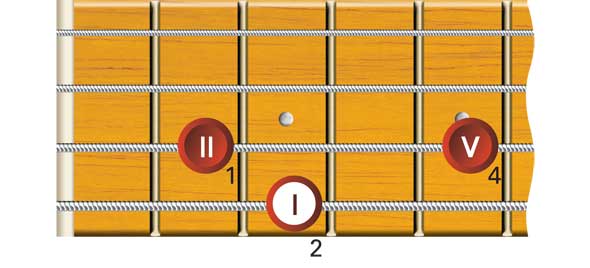
Inversions
Once you have the correct notes for a chord they can be arranged in any order. These various arrangements of the notes within a chord are called inversions. E.g., a G chord could be played G B D (called root position), or B D G (first inversion), or D G B (second inversion). The use of inversions opens up many new fingering possibilities all over the fretboard.
It is worth learning all inversions of each arpeggio, as this enables you to identify all the degrees of the chord (called chord tones) more easily, which means you can respond quickly to what is being played by other musicians you are playing with regardless of the harmony. If you know the notes and inversions of chords well, it also makes it a lot easier to improvise your own bass lines in any position on the fretboard. It is also recommended that you learn at least a bit of basic keyboard or guitar so you get used to hearing the sound of all of the notes of chords together instead of one at a time. Most of the great bass players also have an excellent knowledge of keyboard harmony.
Root Position G

So far all major chords have been introduced in their most basic form with the root note being the lowest note. This is called the root position.
All major chords contain three different notes. These notes can be duplicated and/or played in a different location. When the third (3) is the lowest note of the chord shape, the chord is said to be the first inversion. The following diagram illustrates the first inversion of the G major chord, which contains the notes B (3), D (5), and G (1) in that order.
First Inversion G/B

Note: The chord symbols for inversions are written with a slash, e.g., the first inversion of the G major chord is written as G/B.
When the fifth (5) is the lowest note of the chord shape, the chord is said to be the second inversion. The following diagram illustrates the second inversion of the G major chord, which contains the notes D (5), G (1) and B (3) in that order.
Second Inversion G/D

Note: The second inversion of the G major chord is written as G/D.
The following example combines the inversions of the G major arpeggio patterns.
